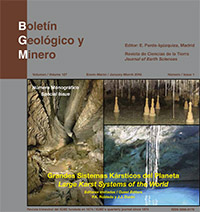An optical laser device for mapping 3D geometry of underwater karst structures: first tests in the Ox Bel’Ha system, Yucatan, Mexico
DOI:
https://doi.org/10.21701/bolgeomin.127.1.007Keywords:
cave, geomorphology, geostatistics, Karst, 3D, laser scannerAbstract
In the course of extended hydrological studies in the coastal Karst plain of Yucatan, near the town of Tulum amongst others, a novel laser scanning device was developed and applied for the acquisition of the 3d-geometry of groundwater conduits. The method is derived from similar industrial systems and for the first time adapted to the specific measurement conditions in underwater cave systems. The device projects a laser line over the whole perimeter at a certain position. This line represents the intersection of a plane with the cave walls. The line is imaged with a wide angle camera system. Through proper design and calibration of the device it is possible to derive the true scale geometry of the perimeter via special image processing techniques. By acquiring regularly spaced images it is possible to reconstruct the true scale and 3d-shape of a tunnel through the incorporation of location and attitude data. In a first test in the Ox Bel Ha underwater cave system, about 800 metres of tunnels have been scanned down to water depths of 20 metres. The raw data is further interpolated using the ODSIM-algorithm in order to delineate the 3D geometry of the cave system. The method provides easy, operable acquisition of the 3-D geometry of caves in clear water with superior resolution and speed and significantly facilitates the measurement in underwater tunnels as well as in dry tunnels. The data gathered represents crucial input to the study of the state, dynamics and genesis of the complex karst water regime.
Downloads
References
Back, W., Hanshaw, B.B., Thomas, E., Pyle, L., Plummer, N., and Weidie, A.E. 1979. Geochemical significance of groundwater discharge and carbonate solution to the formation of Caleta Xel Ha, Quintana Roo, Mexico. Water Resources Research, 15(6), 1521-1535. https://doi.org/10.1029/WR015i006p01521
Bauer-Gottwein, P., Gondwe, B. R. N., Charvet, G., Marín, L. E., Rebolledo-Vieyra, M., Merediz-Alonso, G. 2011. Review: The Yucatán Peninsula karst aquifer, Mexico. Hydrogeology Journal, 19(3), 507-524. https://doi.org/10.1007/s10040-010-0699-5
Beddows, P.A. 2004. Groundwater hydrology of a coastal conduit carbonate aquifer: Caribbean coast of the Yucatán Peninsula, México. PhD Thesis, University of Bristol, Bristol, 303 pp.
Borghi, A., Renard, P., Jenni, S. 2012. A pseudo-genetic stochastic model to generate karstic networks. Journal of Hydrology, 414-415, 516-529. https://doi.org/10.1016/j.jhydrol.2011.11.032
Fisher, R.B., and Naidu, D.K. 1991. A comparison of algorithms for subpixel peak detection. Proceedings of the 1991 British Machine Vision Association Conference (BMVAC 1991), pp.217-225.
Gondwe, B. R. N., 2010. Exploration, modelling and management of groundwater-dependent ecosystems in karst - the Sian Ka'an case study, Yucatan, Mexico. PhD Thesis, Technical University of Denmark, Kongens Lyngby, 86 pp.
Gondwe, B. R. N., Lerer, S. M., Stisen, S., Marin, L., Rebolledo-Vieyra, M., Merediz-Alonso, G., Bauer-Gottwein, P. 2010. Hydrogeology of the south-eastern Yucatan Peninsula: New insights from water level measurements, geochemistry, geophysics and remote sensing. Journal of Hydrology, 389(1-2), 1-17. https://doi.org/10.1016/j.jhydrol.2010.04.044
Henrion,V., Caumon, G., Cherpeau, N., 2010, ODSIM: An Object-Distance Simulation Method for Conditioning Complex Natural Structures. Mathematical Geosciences, 42(8): 911-924 https://doi.org/10.1007/s11004-010-9299-0
Kannala, J., Brandt, S.S., and Heikkilä, J. 2008. Measuring and modelling sewer pipes from video. Machine Vision and Applications, 19(2), 73-83. https://doi.org/10.1007/s00138-007-0083-1
Matsui, K., Yamashita, A., and Kaneko, T. 2009. 3-D shape reconstruction of pipe with omni-directional Laser and omni-directional camera. Proceedings of the 3rd International Conference of Asian Society for Precision Engineering and Nanotechnology (ASPEN2009), 1A2-15, pp.1-5.
Remy, N., Boucher, A., Wu, J., 2011, Applied Geostatistics with SGeMS: A User's Guide. Cambridge University Press, Cambridge, 286 pp.
Schiller, A., Klune, K., and Schattauer, I. 2010. Advanced AEM by comprehensive analysis and modelling of system drift. EGU General Assembly 2010, Geophysical Research Abstracts, 12 EGU2010-11995-1.
Schiller, A., Supper, R., Vuilleumier, C., Ottowitz, D., Ahl, A., and Motschka, K. 2012. Airborne and ground geophysics for modelling a karstic conduit system: New results from the 2007-2011 campaigns in Tulum. Near Surface Geoscience 2012, Remote Sensing Workshop, Proceedings of the 18th European Meeting of Environmental and Engineering Geophysics, Paris.
Schiller, A., Supper, R., Merediz Alonso, G., Ottowitz, D., Vuilleumier, C., Motschka, K. 2013. Aero-electromagnetic mapping of the hidden ground water conduit systems beneath the Tulum Karst plains. IAGA, 12 th scientific assembly, Merida, August 26-31, 2013, abstracts 1.3-7, abstract volume p. 102.
Supper, R., Motschka, K., Ahl, A., Ottowitz, D., Bauer, P., Gondwe, B., Merediz Alonso, G., Römer, A., Kinzelbach, W. 2009. Spatial mapping of submerged cave systems by means of airborne electromagnetics: an emerging technology to support protection of endangered karst aquifers. Near Surface Geophysics, Special Issue on Hydrogeophysics - Methods and Processes, 7(5-6), 613-627. https://doi.org/10.3997/1873-0604.2009008
Supper, R., Schiller, A., Jochum, B., Ottowitz, D. 2010. Geophysikalische Messungen in Tulum (Mexiko) - 2010, Österreichische Akademie der Wissenschaften, online-ISBN: 978-37001-6971-0.
Vuilleumier, C., A. Borghi, P. Renard, D. Ottowitz, A. Schiller, R. Supper and F. Cornaton, 2013. A method for the stochastic modeling of karstic systems accounting for geophysical data: an example of application in the region of Tulum, Yucatan Peninsula (Mexico). Hydrogeology Journal 21(3): 529-544. https://doi.org/10.1007/s10040-012-0944-1
Downloads
Published
How to Cite
Issue
Section
License
Copyright (c) 2024 Consejo Superior de Investigaciones Científicas (CSIC)

This work is licensed under a Creative Commons Attribution 4.0 International License.
© CSIC. Manuscripts published in both the print and online versions of this journal are the property of the Consejo Superior de Investigaciones Científicas, and quoting this source is a requirement for any partial or full reproduction.
All contents of this electronic edition, except where otherwise noted, are distributed under a Creative Commons Attribution 4.0 International (CC BY 4.0) licence. You may read the basic information and the legal text of the licence. The indication of the CC BY 4.0 licence must be expressly stated in this way when necessary.
Self-archiving in repositories, personal webpages or similar, of any version other than the final version of the work produced by the publisher, is not allowed.















